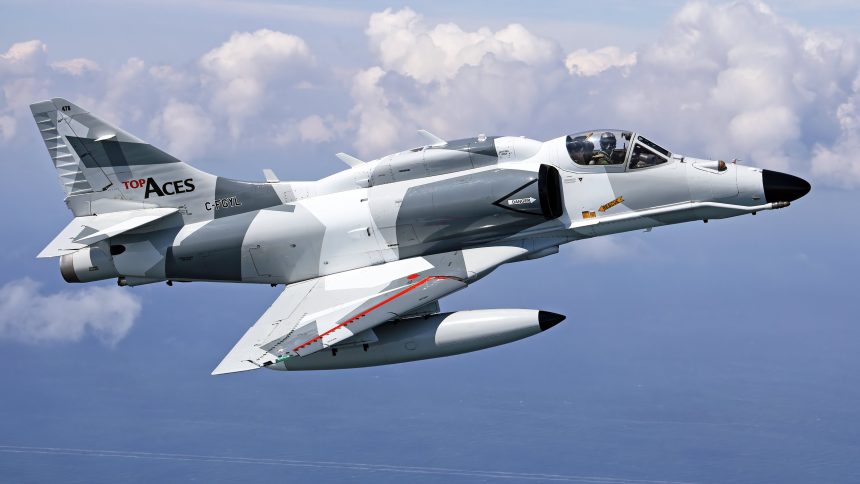The Skyhawks supporting the RCAF have been upgraded by Top Aces to the A-4 Advanced Aggressor Fighter configuration, which includes advanced capabilities and an arctic splinter camo to replicate near-peer threats at lower costs.
Top Aces, the private ADAIR (Advanced Adversary Air) company which provides adversary, or Aggressor, training in support of multiple militaries, is continuing to expand its support to the RCAF (Royal Canadian Air Force). In fact, the company is employing both its A-4s and Alpha Jets, with the former sporting an arctic splinter camo, to support the training of Canadian CF-18 pilots.
Top Aces is the leading private aerial combat training provider in North America, specializing in simulating enemy, or ‘Red’, aircraft, replicating their tactics and technological capabilities. The firm recently shared an image on X showing an example of the missions flown in support of the RCAF, with two A-4N Skyhawks and an Alpha Jet during a tactical air intercept training event.
Captured by one of our pilots during a tactical air intercept training mission, this stunning shot showcases our A-4 AAF and Alpha Jet aircraft in action while supporting the @RCAF_ARC – all proudly sporting the new Arctic camouflage paint scheme!#TacticalTraining… pic.twitter.com/wUmB662clV
— Top Aces (@topaces) November 30, 2024
The two Skyhawks are sporting a blue, white and gray splinter livery, while the Alpha Jet has the classic arctic camouflage with the same colour combination. Top Aces also has some of its A-4 in a two-colour dark and light gray combination, usually seen flying in Europe.
Top Aces has partnered with the CAF (Canadian Armed Forces) since 2005. Like the U.S. Air Force’s dedicated Aggressor squadrons, Top Aces offers what is known as ‘dissimilar combat training’, which puts combat aviators and crews through the paces in diverse scenarios, closest to how enemy air forces might act.
Check out these fantastic photos from a recent mission featuring a mixed adversary force of all three jets from our Canadian fleet: the A-4 AAF, Alpha Jet, and Learjet. ✈️✨
#TopAces #TripleThreat #A4 #AlphaJet #Learjet #YODWingWarDay #AdvancedTraining #AviationExcellence pic.twitter.com/nt9Fv8E4sn
— Top Aces (@topaces) July 8, 2024
Along with A-4s and Alpha Jet, Top Aces also uses the Bombardier Learjet 35A and the F-16A, its most advanced aggressor trainer. The latter, however, is only used by the U.S.-based Top Aces Corp, while the others are used by the parent company in Canada.
The Aviationist had recently reported about Top Aces’ F-16s receiving Leonardo’s SkyWard IRST (Infra-Red Search and Track) pods. These aircraft are retired Israeli Air Force F-16 Netz (Hawk) Fighting Falcons, the first four of which were delivered to Top Aces in 2021. The configuration to which they have been since upgraded is a standard known as F-16 AAF (Advanced Aggressor Fighter).
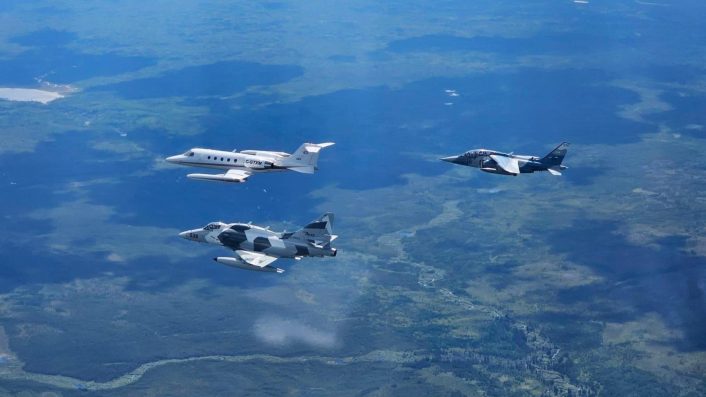
Top Aces and Royal Canadian Air Force
Top Aces announced in June 2024 the successful completion of its first training mission in Canada with the A-4 Advanced Aggressor Fighter (AAF). The company said at the time that the mission marked the start of the AAF service delivery, which followed the contract for the Canadian government’s CATS (Contracted Airborne Training Services) program in Dec. 2023.
We’re thrilled to announce the successful completion of our first training mission in Canada with the A-4 ‘Advanced Aggressor Fighter’ (AAF) Skyhawk!#TopAces #A4Skyhawk #Canada #ExperienceMatters #Aviation #MilitaryTraining #TrainingExcellence pic.twitter.com/kzeffK5xCd
— Top Aces (@topaces) June 20, 2024
The first two A-4 AAFs arrived in Canada in late May, adding to Top Aces’s existing Canadian aggressor fleet of Dassault/Dornier Alpha Jets and Bombardier Learjet 35s. Each A-4 AAF aircraft is equipped with Top Aces’ proprietary, open architecture AAMS (Advanced Aggressor Mission System), allowing it to “replicate the advanced systems of a near-peer, threat aircraft.”
That first mission in June 2024 saw an A-4 AAF and a formation of Alpha Jets, conducting air-combat training in support of RCAF CF-18 pilots based out of 4-Wing Cold Lake, Alberta, said the company. Beside enhancing the skills of the CF-18 aircrew, the introduction of the A-4 AAF aircraft allows the RCAF to refocus its resources on “higher value training activities” as they prepare for the F-35 transition, leaving the less mundane activities to Top Aces.
On August 28, 🇨🇦 #NORAD Region CF-18s intercepted a @topaces ✈️ as part of a cross-border intercept training scenario during Ex #FabricHawk. #WeHaveTheWatch @NORADCommand @RCAF_ARC pic.twitter.com/o86lulYZEr
— RCAF Operations (@RCAFOperations) September 4, 2024
The RCAF has been in fact recently working to better manage its limited resources and focus them on the introduction of the new combat aircraft and training. The service says it is on the “cusp of a period of modernization not seen since the Second World War,” impacting “nearly every fleet of aircraft and all members” of the RCAF.
Also, the acquisition of the CF-35 (how the F-35 will be designated by Canada) is the largest investment of the RCAF in the past 30 years, with an estimated investment of $19 billion. The aircraft will replace the CF-188s (commonly known as CF-18, Canadian variant of the F/A-18A) based in Bagotville and Cold Lake.
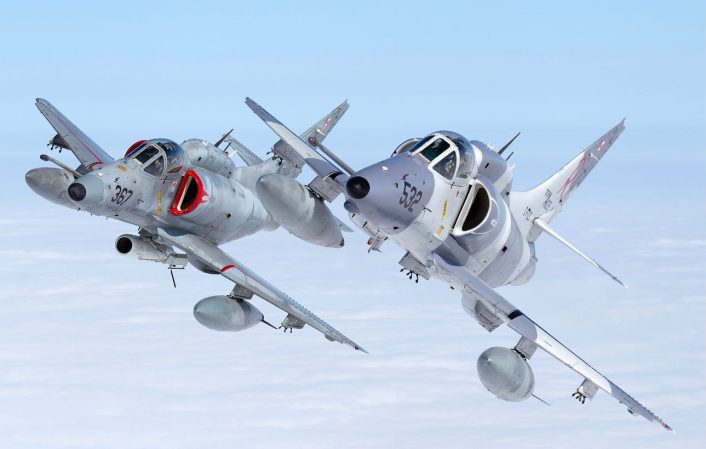
A-4N Skyhawk
Top Aces employs the A-4N variant of the Skyhawk, which was upgraded extensively while in service with the Israeli Air Force. The company acquired the Skyhawk as it was a “proven and trusted platform for all mission profiles.”
The aircraft is used for a multitude of roles, including day and night JTAC (Joint Terminal Attack Controller) training; weapons delivery, adversary support and anti-shipping attack training for naval forces, “Red Air” adversary support for fighter forces, air-to-air gunnery target tow, Electronic Warfare training, missile and radar profile simulations, as well as Research, Development, Test & Evaluation (RDT&E).
The single and dual-seat Skyhawks have been initially upgraded by Top Aces to have a modernized IFR (Instrument Flight Rules) avionics, TACAN (Tactical Air Navigation System) and ESCAPAC ejection seats for maximum operational flexibility and aircrew safety. “In addition, we’re now integrating our proprietary Advanced Aggressor Mission System onto our Skyhawks, allowing our aircraft to simulate the highly advanced capabilities of latest generation air-to-air combat opponents,” Top Aces added.
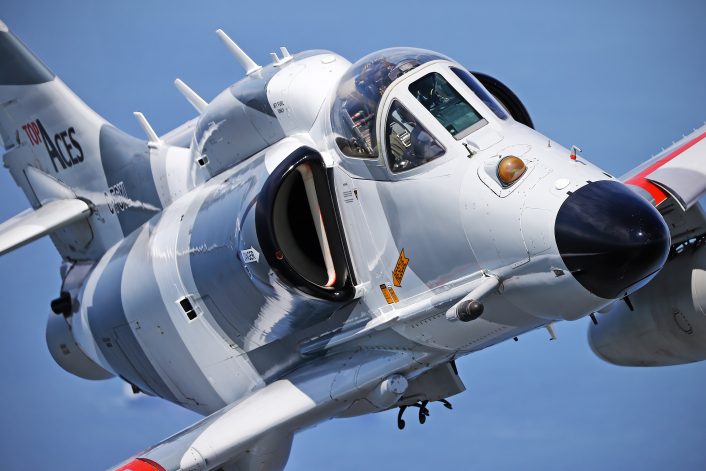
As part of the AAMS program, launched in 2021, Top Aces is integrating even more modern systems on the A-4N. In fact, the upgrade, powered by an open-system architecture, includes an Active Electronically Scanned Array (AESA) radar, Helmet-Mounted Cueing System (HMCS), tactical datalink, Infrared Search and Track (IRST) system, High Fidelity Weapon Simulation and Advanced Electronic Attack pod capability.
With the IRST sensor, our A-4 Skyhawk will ensure realistic and effective training for military forces, preparing them for the complexities of modern air combat. We’re proud to deliver innovative solutions that enhance our training capabilities!
Photos Credit: Aviation PhotoCrew pic.twitter.com/KY7Oo5vkvk
— Top Aces (@topaces) July 11, 2024
WIth all the new capabilities of the A-4 AAF, the CF-18 will be required to fly fewer Red Air missions, concentrating on flying Blue Air missions to train on their actual tactics, techniques and procedures. In fact, before the AAMS program, CF-18s were often required to also support the Red Air to simulate radar-equipped adversaries, but this can now be done by the A-4 AAF which will also be able to provide networked aggressors capable of passively detecting Blue Air through the IRST system.
The Hornet Extension Project
The introduction of Top Aces’ A-4 AAF into the Canadian CATS contract coincides with completion of an upgrade program for the CF-18s, known as the Hornet Extension Project (HEP). The project is meant to ensure the CF-18 can meet the operational commitments until 2032, when the CF-35 is expected to be operational.
The CF-18 Hornet Extension Project (HEP) has achieved Initial Operational Capability, delivering the first six operational aircraft as part of phase 2 of the project. The HEP remains on schedule to achieve Full Operational Capability by March 2026. pic.twitter.com/Qu0frqzaq0
— Royal Canadian Air Force (@RCAF_ARC) July 8, 2024
The upgrade, divided in two phases, was first approved in 2019 and the upgraded CF-18s reached the Initial Operational Capability (IOC) on June 24, 2024, while the Full Operational Capability (FOC) is planned for 2026. The milestone was also the result of a five-year collaborative effort with the U.S. Navy’s F/A-18 and EA-18G Program Office (PMA-265).
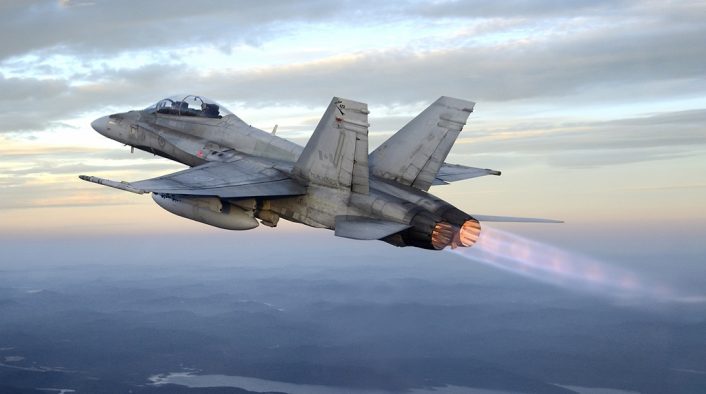
The Phase 1 of HEP ensured interoperability and aviation regulatory upgrades for up to 84 CF-18 aircraft. These included a new ADS-B-compatible transponder and IFF (Identification Friend or Foe), Link 16 datalink, satellite communications, upgrades to mission computer and software, upgraded targeting pod and night vision capability for the Helmet Mounted Display (HMD).
Phase 2 provided further upgrades to 36 CF-18s which underwent Phase 1. These included a new APG-79(V)4 AESA radar, new air-to-air missiles, upgraded software and Automatic Ground Collision Avoidance System (AGCAS). The IOC was reached when the first six CF-18 which underwent Phase 2 were delivered to 3 Wing Bagotville.

